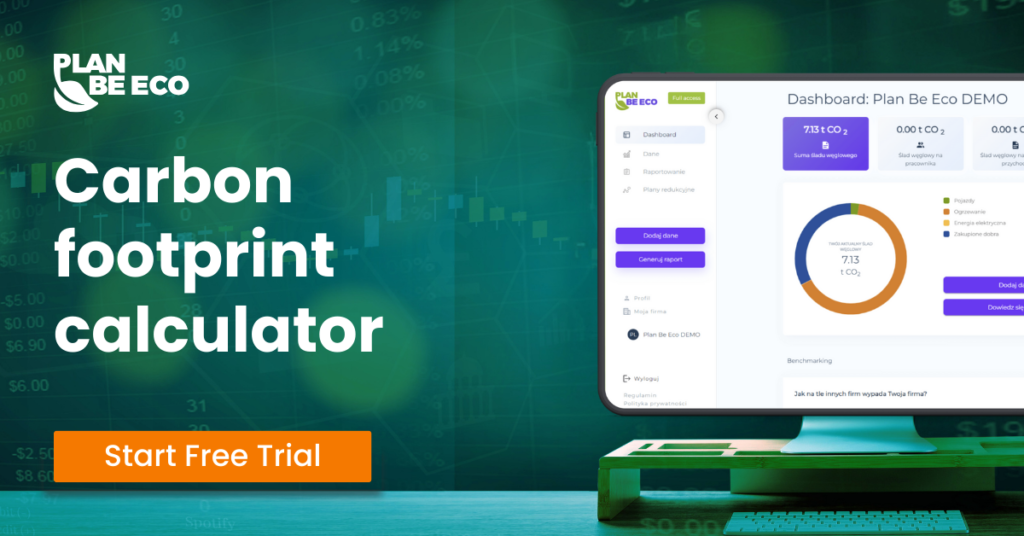VSME – Voluntary Sustainability Reporting Standard for non-listed SMEs
![plan_be_eco_[VSME – Dobrowolny Standard Raportowania Zrównoważonego Rozwoju dla nienotowanych MŚP]_[pl]](https://planbe.eco/wp-content/uploads/2025/04/plan_be_eco_VSME-–-Dobrowolny-Standard-Raportowania-Zrownowazonego-Rozwoju-dla-nienotowanych-MSP_pl-1024x536.png)
Table of content
Faced with increasing reporting requirements on environmental, social, and governance (ESG) issues, unlisted micro, small, and medium-sized enterprises (SMEs) are often challenged to meet the expectations of business partners, financial institutions, or investors.
To facilitate the ESG reporting process for these companies, the European Financial Reporting Advisory Group (EFRAG) developed and published on 17 December 2024 the Voluntary Sustainability Reporting Standard for non-listed SMEs, known as VSME (Voluntary Sustainability Reporting Standard for non-listed SMEs).
What is the VSME standard and what is its purpose?
VSME is a voluntary guideline designed for micro, small and medium-sized companies that are not subject to the reporting obligations of the Corporate Sustainability Reporting Directive (CSRD). The standard is designed to enable these companies to present ESG information in a simplified, proportionate and tailored manner to better meet the growing information needs of business partners and financial institutions.
The VSME Standard is worth implementing now, as it provides an excellent preparation for micro, small, and medium-sized companies for future mandatory reporting in line with the requirements of the CSRD and the EU Omnibus Regulation.
Although VSME is currently voluntary, its structure and thematic scope follow the ESRS approach, allowing companies to progressively develop competencies, collect relevant data, and implement the necessary reporting processes. This is particularly important in light of the upcoming regulations, which could also extend to smaller players in the supply chains of larger companies in about two years.
Differences between VSME and ESRS standards
The VSME (Voluntary Sustainability Reporting Standard for non-listed SMEs) and ESRS (European Sustainability Reporting Standards) differ in scope, mandatory scope, and level of detail due to their different objectives and target groups.
1. Mandatory scope and coverage
ESRS is mandatory for large companies and some medium-sized listed companies, as required by the CSRD. In contrast, VSME is a voluntary standard aimed at unlisted micro, small, and medium-sized companies that wish to report on sustainability issues in a simplified manner.
2. Scope and detail
ESRS covers a wide range of topics, including climate change, biodiversity, social issues, and governance. In contrast, VSME focuses on key aspects of ESG, offering approximately less data in the core module and a possible supplement in the comprehensive module, making it more accessible to SMEs.
3. Double materiality analysis
ESRS requires a double materiality analysis, which can be complicated for smaller companies. VSMEs do not require such an analysis; instead, they use an “if applicable” approach, allowing companies to omit certain disclosures if they are not material to their business.
4. Structure and flexibility
VSMEs consist of two modules: a core and a comprehensive module, allowing companies to tailor the scope of reporting to their needs and capabilities. ESRS has a more complex structure, with a set of thematic and cross-cutting standards, which may require more resources and advanced knowledge.
Structure of the VSME standard for small and medium-sized enterprises
The VSME standard consists of two modules that companies can implement according to their needs and capabilities:
- Basic Module – for the smallest companies; does not require a double materiality analysis and includes basic ESG information.
- Comprehensive Module – for companies that have policies and targets in ESG areas and for those whose business partners expect more detailed ESG data; requires a double materiality analysis and includes more detailed disclosures.
It is worth noting that the use of the Basic Module is a prerequisite for the implementation of the Comprehensive Module.

VSME Basic Module
The core module within the VSME standard is designed for a simplified but comprehensive approach to ESG reporting by unlisted micro, small and medium-sized companies. It consists of 11 mandatory disclosures (B1-B11) that cover key environmental, social and corporate governance aspects.
B1 – Basis for report preparation: Provides information on the scope of reporting (whether it covers only the core module or also the comprehensive module), any omissions of data due to company confidentiality, the nature of the report (consolidated or stand-alone), basic company data (number of employees, turnover, NACE codes) and sustainability certifications held.
B2 – Sustainability policies and objectives: Describes disclosures on the company’s existing ESG and negative impact reduction practices, policies, initiatives and targets.
B3 – Energy consumption and emissions: Presents data on energy consumption and Scope 1 and 2 greenhouse gas emissions.
Decarbonisation step by step: a recipe for a competitive and resilient business – read the article
B4 – Environmental pollution: Includes information on air, water and soil pollution.
B5 – Biodiversity: Addresses the impact of the company’s activities on biodiversity.
B6 – Water management: Includes data on water use and abstraction.
B7 – Circular economy: Presents information on activities related to the circular economy.
B8 – Workers: Contains data on the number of workers, types of contracts, gender structure and countries of employment.
B9 – Occupational safety: Provides information on accidents at work, deaths and occupational diseases.
B10 – Wages and training: Presents information on wages, gender pay gaps, collective bargaining agreements and hours allocated to employee training.
B11 – Anti-Corruption: Refers to convictions and fines related to corruption and bribery.
An important aspect of the core module is that no materiality analysis is required, which simplifies the reporting process. Additionally, the “if applicable” approach allows companies to omit certain disclosures if they are not material to their business. This flexible approach is intended to reduce the reporting burden for SMEs.
Comprehensive module for the SME sector
The comprehensive module consists of 9 disclosures that may be additionally required by the SME’s business counterparties.
- C1 – key elements that make up the business model and strategy of the company, e.g. grouped products/services, key markets, business relationships, and whether the strategy is linked to sustainability
- C2 – description of practices, policies, and future initiatives in the transition to a sustainable economy
- C3 – emission reduction targets, which may also include Scope 3 emissions
- C4 – climate risks m. e.g. a description of how their exposure has been assessed, including in the value chain, and whether the company has taken action to adapt to climate change
- C5 – if the company has 50 or more employees, it should disclose information on If the company has 50 or more employees, it should disclose information on the gender ratio of management level employees and self-employed persons working exclusively for the company.
- C6 – Information on human rights policies and processes, such as child labor, forced labor, and other forms of discrimination. C6 – information on human rights policies and processes, including, for example, child labor, forced labor, discrimination
- C7 – whether the company has a history of human rights abuses and what action it has taken to address them
- C8 – income from certain sectors and exclusion from EU benchmarks, including information on controversial arms, tobacco cultivation and production, fossil fuel activities, and chemical production
- C9 – gender diversity on boards of directors
How does VSME help companies adapt to regulatory changes?

How does VSME help companies adapt to regulatory changes?
Preparation for future CSRD compliance – if CSRD thresholds change and a company becomes subject to reporting obligations, companies already using VSME will have a structured system in place.Easier management of sustainability data – companies that have an ESG reporting process in place now will be better equipped to respond to regulatory and stakeholder data requests.
Competitive advantage – companies that start tracking their environmental and social impacts now will be ahead of competitors who delay ESG reporting.
What are the benefits of VSME implementation?
Adopting a VSME standard can bring several benefits to companies:
Increased transparency – standardizing and structuring ESG information increases a company’s credibility in the partner’s eyes.
Facilitating access to finance – standardised ESG reporting can improve relationships with banks and investors, making it easier to access green finance.
Preparing for future regulation – implementing VSME allows companies to better prepare for possible future reporting obligations.
Building a competitive advantage – a commitment to sustainability can be an important differentiator for a company in the market.
ESG reporting – an obligation or a strategic investment in a company’s future? Read here.
Will VSME support companies in calculating and reducing their carbon footprint?
Yes, the VSME standard can effectively support companies in counting and reducing their carbon footprint. VSME’s core module includes mandatory reporting of Scope 1 and 2 (Scope 1 and 2) greenhouse gas emissions, allowing companies to monitor the direct and indirect emissions associated with their operations.
For companies that are ready for more advanced measures, the comprehensive module also allows for Scope 3 (Scope 3) emissions reporting, and requires the setting of emission reduction targets and strategies for the transformation towards a low-carbon business model. This allows SMEs not only to gain environmental transparency, but also to take concrete steps towards reducing their climate impact.
It is worth emphasizing that only full value chain reporting – covering emissions from all three scopes (1, 2, and 3) – provides a complete and realistic picture of a company’s carbon footprint. Scope 3, which includes emissions from suppliers, logistics partners, or the product life cycle, often represents the largest percentage of total emissions. Omitting this element can lead to a significant underestimation of a company’s true climate impact.
What is scope 3? Find out by reading our article!

Where to look for information on VSME?
EFRAG has made available a range of educational resources – including webinars, presentations and instructional videos – to support companies in understanding and implementing the VSME standard. These resources are available free of charge on the EFRAG website and include automatic subtitles in multiple languages, making it much easier for companies operating in different European countries to access the knowledge.
In addition, information and interpretations on VSME can also be found on the websites of the ministries and institutions responsible for the implementation of sustainable development regulations in individual EU Member States.
Summary
The Voluntary Sustainability Reporting Standard for the SME sector is an important tool to support micro, small and medium-sized enterprises in reporting ESG issues in an effective and proportionate manner. Through its flexible structure and the availability of educational materials, VSME enables companies to increase transparency, facilitates access to finance and prepares them for the future challenges of sustainability reporting.
Plan Be Eco can effectively support companies in implementing the VSME standard by offering a comprehensive approach based on sustainability expertise and experience. Our team of experts helps companies understand the requirements of the standard, collect relevant data and prepare for future CSRD-compliant reporting.
What’s more, Plan Be Eco provides precise carbon footprint counting across the entire supply chain – covering Scope 1, 2 and 3 emissions – allowing companies to gain a complete picture of their climate impact and develop effective emission reduction strategies. With our tools and advisory support, companies can not only meet increasing regulatory requirements, but also build real value through responsible environmental management.

